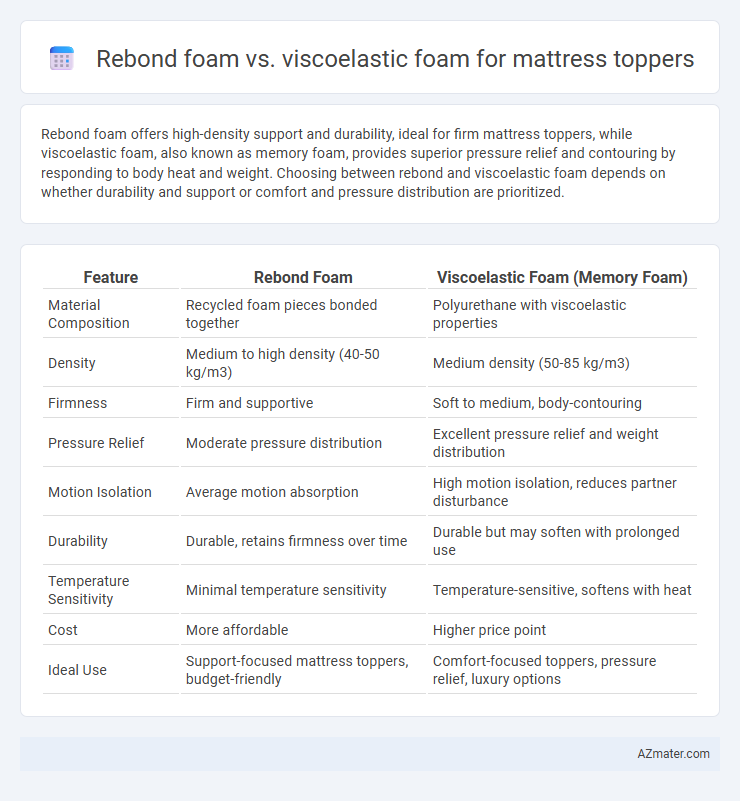Rebond foam offers high-density support and durability, ideal for firm mattress toppers, while viscoelastic foam, also known as memory foam, provides superior pressure relief and contouring by responding to body heat and weight. Choosing between rebond and viscoelastic foam depends on whether durability and support or comfort and pressure distribution are prioritized.
Table of Comparison
| Feature | Rebond Foam | Viscoelastic Foam (Memory Foam) |
|---|---|---|
| Material Composition | Recycled foam pieces bonded together | Polyurethane with viscoelastic properties |
| Density | Medium to high density (40-50 kg/m3) | Medium density (50-85 kg/m3) |
| Firmness | Firm and supportive | Soft to medium, body-contouring |
| Pressure Relief | Moderate pressure distribution | Excellent pressure relief and weight distribution |
| Motion Isolation | Average motion absorption | High motion isolation, reduces partner disturbance |
| Durability | Durable, retains firmness over time | Durable but may soften with prolonged use |
| Temperature Sensitivity | Minimal temperature sensitivity | Temperature-sensitive, softens with heat |
| Cost | More affordable | Higher price point |
| Ideal Use | Support-focused mattress toppers, budget-friendly | Comfort-focused toppers, pressure relief, luxury options |
Introduction to Mattress Topper Materials
Rebond foam mattress toppers consist of shredded memory foam pieces bonded together, offering firm support with high durability and breathability. Viscoelastic foam, commonly known as memory foam, adapts to body contours by responding to heat and pressure, providing exceptional pressure relief and motion isolation. Both materials enhance mattress comfort but differ in responsiveness and support levels, catering to varying sleep preferences and ergonomic needs.
What is Rebond Foam?
Rebond foam is a dense material created by shredding and compressing scrap polyurethane foam pieces to form a durable and supportive mattress topper offering firm pressure relief and enhanced longevity. Compared to viscoelastic foam, which conforms slowly to body heat and pressure for contouring support, rebond foam provides a more resilient and springy feel that resists sagging over time. Its high density and firmness make rebond foam ideal for sleepers needing robust support and durability in mattress toppers.
What is Viscoelastic (Memory) Foam?
Viscoelastic foam, commonly known as memory foam, is a pressure-sensitive material that conforms closely to body contours by responding to heat and weight, providing personalized support and enhanced comfort. Unlike rebond foam, which is denser and firmer due to its composition of shredded polyurethane foam pieces, viscoelastic foam absorbs shock and reduces pressure points, making it ideal for mattress toppers aimed at improved spinal alignment and pain relief. This viscoelastic property allows memory foam to slowly return to its original shape, offering durability and long-lasting resilience in bedding applications.
Comfort & Support Comparison
Rebond foam offers firm support with high-density properties, making it ideal for users seeking durable pressure relief and stability in a mattress topper. Viscoelastic foam, also known as memory foam, contours closely to the body by responding to heat and weight, providing superior comfort and personalized support that reduces pressure points. While rebond foam excels in resilient support and longevity, viscoelastic foam prioritizes adaptive comfort and enhanced spinal alignment for a softer sleep experience.
Durability and Longevity
Rebond foam exhibits high durability due to its dense composition of shredded foam pieces fused together, making it resistant to sagging and deformation over time. Viscoelastic foam, known as memory foam, offers excellent longevity by contouring to body shape and slowly returning to its original form, although it may degrade faster in high-humidity environments. Both foams provide lasting support, but rebond foam generally outperforms in terms of structural integrity and extended lifespan under heavy use.
Temperature Regulation Properties
Rebond foam tends to retain heat due to its dense structure, which can lead to a warmer sleep experience compared to viscoelastic foam. Viscoelastic foam, often known as memory foam, incorporates open-cell technology and gel infusions that enhance airflow and dissipate heat efficiently, promoting better temperature regulation. Mattress toppers made of viscoelastic foam are generally preferred for sleepers seeking a cooler surface and improved breathability throughout the night.
Pressure Relief Capabilities
Rebond foam offers firm support with moderate pressure relief by redistributing body weight evenly across the mattress topper, making it suitable for those needing extra durability and density. Viscoelastic foam, also known as memory foam, excels in pressure relief by contouring closely to the body's shape, reducing pressure points and improving spinal alignment for enhanced comfort. Mattress toppers made from viscoelastic foam typically provide superior pressure distribution compared to rebond foam, benefiting users with joint pain or sensitive pressure areas.
Motion Isolation Performance
Rebond foam exhibits moderate motion isolation by absorbing impact and reducing vibrations, making it suitable for individuals with lighter sleep disturbances. Viscoelastic foam, also known as memory foam, offers superior motion isolation due to its viscoelastic properties that contour to body shape and minimize motion transfer between sleep partners. Studies show that viscoelastic foam mattress toppers can reduce motion disturbance by up to 90%, outperforming rebond foam in minimizing sleep disruption caused by partner movement.
Price Differences and Value
Rebond foam mattress toppers are generally more affordable due to their denser, recycled material composition, making them a budget-friendly option for added mattress support. Viscoelastic foam, commonly known as memory foam, typically comes at a higher price point because of its advanced pressure-relieving properties and superior comfort. While rebond foam offers economy and durability, viscoelastic foam delivers enhanced body contouring and long-term value, justifying the investment for those seeking improved sleep quality.
Choosing the Right Foam for Your Needs
Rebond foam offers firm support and durability, making it ideal for individuals seeking a resilient mattress topper with excellent bounce and pressure distribution. Viscoelastic foam, also known as memory foam, contours closely to the body, providing superior pressure relief and reduced motion transfer for those prioritizing comfort and pain reduction. Selecting the right foam depends on your preference for firmness versus cushioning, sleep position, and any specific orthopedic concerns.

Infographic: Rebond foam vs Viscoelastic foam for Mattress topper
 azmater.com
azmater.com